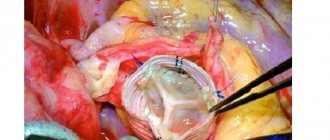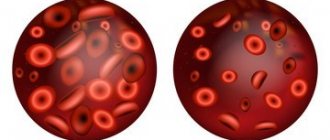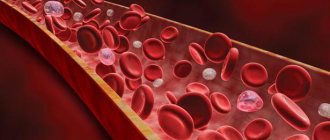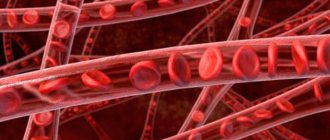What is anemia in children?
is a pathological condition characterized by a decrease in the content of
blood per unit volume, usually with a simultaneous decrease
in relation to the physiological level necessary to satisfy tissue oxygen needs. Such a condition as anemia deciphers itself - there is not enough blood.
Blood, in turn, consists of the following parts:
- liquid part - plasma;
- shaped elements.
- water (occupies 80%);
- proteins;
- fats;
- carbohydrates;
- enzymes and hormones;
- biologically active substances.
These cells differ in shape, size and function.
There are fewer leukocytes in the blood, they have a nucleus and do not have a permanent shape. Platelets are presented in the form of thin plates. They are responsible for blood clotting, stopping bleeding.
Most of the blood contains red blood cells. They are red blood cells of a biconvex shape, lacking a nucleus. The cavity of the red blood cell is filled with hemoglobin, a special protein that contains iron.
Due to hemoglobin, red blood cells transport various gases, in particular, the delivery of oxygen to organs and tissues. Due to a lack of hemoglobin in the blood, anemia develops and the body experiences oxygen starvation.
Blood cells are formed in red bone marrow.
The hematopoietic system consists of a group of central and peripheral organs responsible for the constancy of blood composition in the human body.
A type of bone marrow consisting of fibrous and hematopoietic tissue. Most red bone marrow is located inside the bones of the pelvis, sternum and ribs.
Spleen Parenchymal organ located in the abdominal cavity. The internal contents of the spleen are divided into two zones - the red pulp and the white pulp.
Mature blood cells accumulate in the red pulp, most of which are red blood cells. White pulp consists of lymphoid tissue, in which the production of lymphocytes, the main cells of the human immune system, occurs.
Lymph nodes are peripheral organs of the lymphatic system. Lymph nodes produce lymphocytes as well as plasma cells.
The latter are the main cells producing antibodies in the human body. Antibodies, in turn, are necessary to identify and neutralize various foreign objects (for example, viruses, bacteria).
The following types of anemia are distinguished:
- posthemorrhagic anemia;
- Iron-deficiency anemia;
- folate deficiency anemia;
- B12 deficiency anemia;
- dyserythropoietic anemia;
- hypoplastic (aplastic) anemia;
- hemolytic anemia.
Among the above anemias in children, the most common are iron deficiency, hemolytic and B12 deficiency anemia.
The severity of anemia in children The severity of anemia depends on the severity of the decrease in hemoglobin levels. With mild severity, the hemoglobin level is more than 90 g/l.
Types and forms of anemia
Anemia of any severity has several forms, and if iron deficiency can be treated with specially developed drugs that increase hemoglobin levels, then hemolytic and aplastic anemia requires surgical intervention. Only a qualified doctor can make an accurate diagnosis after a full examination of the patient, during which a detailed blood test and examination of the condition of the internal organs, including the hematopoietic organs, are necessary.
Possible complications
Anemic syndrome, provided that it is not treated in any way, can lead to the following consequences:
- anemic coma;
- dysfunction of internal organs;
- lag in physical and mental development compared to peers;
- a decrease in the immune system, making the child more susceptible to various infectious or inflammatory diseases.
If not diagnosed promptly, an anemic condition can be very dangerous. Prolonged oxygen starvation of body tissues leads to the development of persistent abnormalities in the functioning of internal organs. The longer hypoxia develops, the greater the likelihood of complications.
Most often, anemic syndrome leads to:
- Development of immunodeficiency states. An insufficiently active immune system makes the baby more susceptible to various infectious diseases. Even a common cold can last quite a long time and require higher doses of medications.
- Development of cardiovascular pathologies. An anemic state contributes to the development of oxygen starvation. This process is especially dangerous for the heart muscle and brain. With prolonged hypoxia, which develops as a result of anemia, myocarditis can occur. This condition is manifested by a violation of the contractile function of the heart and leads to heart rhythm disturbances.
- The appearance of persistent disorders of the nervous system. Severe dizziness, a feeling of pulsation in the temples, a diffuse severe headache - all these signs can be manifestations of complications of an anemic condition.
- Development of pathological conditions of the gastrointestinal tract. Long-term bowel dysfunction can lead to the development of dysbiosis and irritable bowel syndrome in children.
- Memory impairment and difficulty remembering new material. This manifestation of the disease is most dangerous at school age. The inability to concentrate for long periods of time and decreased memory contribute to a child’s decline in school performance.
- Asthenization. In severe cases of the disease, children experience severe general weakness. With prolonged development of the disease, even some malnutrition and even muscle atrophy are observed. The child appears excessively tired and exhausted.
How does the first degree of anemia manifest during pregnancy?
Anemia of the 1st degree often occurs while a woman is carrying a child. The expectant mother will find out about this immediately after taking the first blood tests. Even if there are no signs of anemia, the baby is already beginning to suffer from a lack of nutrients and oxygen entering the placenta.
Pregnant women should eat well and adhere to a special diet, but also include more iron-containing foods in their diet. This is especially important so that the disease of the first degree does not develop into a more severe form of the disease.
- chicken eggs, especially yolks;
- beef liver;
- veal or beef heart;
- veal or beef tongue;
- turkey meat;
- beef meat;
- dairy products;
- cocoa;
- apricots;
- almond;
- buckwheat;
- fresh fruits and berries;
- fruit juices;
- dried fruits;
- legumes, etc.
If you suspect anemia, it is recommended to follow a diet with iron-containing foods, both at the beginning of pregnancy and closer to childbirth, as a preventative measure.
Diagnostics
Only a specialist can detect anemia. It is enough for the patient to correctly respond to the symptoms signaling this condition and immediately consult a doctor.
For the initial detection of anemia it is necessary:
- Get examined by a specialist
- Take a general blood test in expanded form.
If necessary, a more detailed diagnosis of anemia can be carried out, which includes:
- Blood chemistry
- Examination of the condition of the mucous membrane of the duodenum, large and small intestines, and stomach
- Consultation with a hematologist, who may prescribe additional tests
- Visiting a gynecologist for women.
Additional research techniques are required mainly to determine the specific type of anemia.
Classification by disease mechanism
Currently, there are a huge variety of different anemic conditions. Modern classifications make it possible to distribute pathologies similar in reasons of development into certain groups.
All anemic conditions can be divided into several groups:
- Hemolytic. Characterized by increased destruction of red blood cells. Often occur as hereditary diseases or as a result of long-term use of medications.
- Posthemorrhagic. Occur after massive bleeding, leading to a pronounced loss of circulating blood volume. They can occur at any age. They are characterized by both a decrease in the total number of red blood cells and hemoglobin.
- Iron deficiency. Characterized by low iron levels. Such deficiency forms of anemia occur mainly due to poor nutrition, as well as chronic intestinal diseases. They can also become the only manifestation of a growing tumor. They can be hyper- and hypochromic.
- Folate deficient. Occurs with reduced folic acid levels. Most often they begin to develop during the period of intrauterine development. They can occur in babies and after birth as a result of insufficient intake of folic acid from the outside, as well as in chronic diseases of the stomach and intestines.
- B12-deficient. Characterized by low levels of vitamin B12 in the body. They develop in diseases of the gastrointestinal tract, as well as during helminthic infestations. They are often combined with folate deficiency anemia.
- Hereditary. As a result of Minkowski-Choffard disease, rapid and pathological destruction of altered red blood cells occurs. Hereditary forms of the disease are quite rare. Every three out of ten thousand babies born have this disease. The disease manifests itself already in the 1st year of a child’s life, having a genetic predisposition.
- Hypoplastic or aplastic. Occur due to impaired bone marrow function. As a result of this condition, virtually no new red blood cells are formed. The accelerated destruction of red blood cells only worsens the anemic condition.
Pathogenetic classification
The most common classification of anemia is based on pathogenesis. It provides an opportunity to understand the mechanism of disease development in accordance with the number of reticulocytes, peripheral blood smear, and erythrocyte indices. Also, such a classification will help in studying the complete clinical picture.
The first group is anemia that occurs against the background of hypofunction of the bone marrow with a decrease in the production of red blood cells. Here, myelophthisic, aplastic, and hypoplastic anemia are distinguished and are associated with replacement of hematopoietic tissue or bone marrow damage. Megaloblastic anemia is caused by a deficiency of folic acid and vitamin B12, microcytic and hypochromic anemia is caused by bone marrow hypofunction. There are also anemias, the development of which is associated with excessive loss of red blood cells, incomplete synthesis of globin, genetic defects of red blood cells, exogenous allergens, and mixed diseases.
Classification by severity
First degree anemia refers to a mild variant of the disease. Laboratory values drop to 90 g/l. This is almost always the only symptom of anemia, and the patient may not know anything about it.
Serious symptoms appear in more severe stages of the disease. With moderate anemia, fatigue and shortness of breath begin to bother you even with the body’s usual load.
With severe disease, laboratory values become less than 70 g/l.
In children, iron deficiency anemia most often develops, the main cause of which lies in the deficiency of this element. According to statistics, every 3 babies suffer from such a deficiency.
Iron is the main structural component of hemoglobin; its deficiency to varying degrees will determine the complexity and severity of the disease. Stage 1 anemia in children is characterized by a decrease in hemoglobin levels above 90 g/l.
In case of mild anemia, the examination of the child begins with the appearance, after which laboratory tests are necessary to monitor the hemoglobin level and the quality of treatment.
Deterioration of the child’s condition is accompanied by the addition of specific symptoms. With anemia of 2nd severity, the hemoglobin level is in the range of 70 – 90 g/l.
In addition to the pallor of the skin, the mucous membranes also lose their color, stomatitis may occur in the oral cavity, and problems with the intestines are less common.
The most severe anemia is grade 3, in which the hemoglobin level drops below 70 g/l. The skin and mucous membranes become pale, dry skin appears, stomatitis occurs in the oral cavity, as well as cracks in the corners of the mouth, followed by the addition of a secondary infection - seizures. Children often develop constipation.
There are three degrees of anemia: severe, moderate and mild. Anemia 1 is considered a mild form of the disease. The disease is characterized by a decrease in hemoglobin from 110 to 90 g/l and the disease occurs without clinically visible signs, that is, in life a person may not know about the existence of a problem until he takes a blood test for hemoglobin.
If the first signs of the disease begin to appear with normal stress on the human body, then this corresponds to the second degree of severity of the disease.
Juice mixture. Mix the juices of pomegranate, apple, carrot, beet, and lemon in equal proportions. Add honey to the resulting mixture. Store the product in the refrigerator and take two tablespoons three times a day daily.
Yarrow decoction. The herb is steamed in a thermos for about an hour. Take two tablespoons three times a day.
Stewed juice. Mix juice from carrots, beets and black radish in equal proportions. Keep the juice mixture in the oven for about an hour, without bringing it to a boil. Take two tablespoons twenty minutes before meals.
Dried forest plantain leaves. Use as a spice and add when baking buns or flatbreads.
Rowan tea. To prepare tea you will need two teaspoons of rowan berries and two glasses of boiling water. The product is infused for thirty minutes. Take a glass twice a day. Tea can also be made from rose hips and blueberries.
During the period when young nettles appear, it is useful to prepare soups with the addition of leaves.
Traditional recipes can be combined with diet and medications prescribed by a doctor. When treating mild anemia, these drugs should definitely be combined with medications, this is the only way to increase the likelihood of recovery and removal of signs of the disease.
During the development of anemia, the level of hemoglobin decreases. The lower it is, the more adverse anemic symptoms can develop.
According to the level of reduction of this indicator, all anemias are divided into:
- Lungs. The hemoglobin level is more than 90 g/liter. The severity of clinical symptoms is insignificant. Often this condition is detected accidentally during screening or when taking a general blood test due to other diseases.
- Medium heavy. Hemoglobin levels range from 70 to 90 g/liter. Symptoms are more pronounced. Strong changes in tissue respiration are observed. The condition requires mandatory treatment and prescription of medications for a course.
- Heavy. Occur when hemoglobin decreases below 70 g/liter. Accompanied by a severe violation of the general condition. They require immediate identification of the cause of the disease and immediate prescription of medications.
Treatment of anemia
Before starting treatment for anemia associated with a lack of iron in the body, the causes of the deficiency are established. Then a special diet is prescribed, which necessarily includes meat products - veal and liver, and plant products:
- beans;
- soy;
- parsley;
- spinach;
- peas;
- buckwheat grain;
- bread.
Replenishing the missing substance by introducing a special diet will not be enough, since no more than 3-5 mg of substances are absorbed per day. Together with taking medications - Zhektofer, Conferon, Feramide, etc., the substance is absorbed twenty times faster.
When treating anemia caused by vitamin B-12 deficiency, parasite medications may be prescribed as a preventative measure. The vitamin is prescribed intramuscularly at 200-500 mcg. It is also recommended to eat foods containing this substance:
- liver;
- kidneys;
- fish;
- seafood;
- milk;
- eggs;
- hard cheeses.
Treatment of anemia caused by a lack of folic acid is taking medications containing the missing component. Women should take 5 mg per day for a month.
- fresh fruits;
- dill;
- parsley;
- green onions;
- broccoli;
- cauliflower;
- cereal porridge.
Treatment of hemolytic anemia depends on the symptoms of the disease. If the symptoms of the disease are mild, then treatment is not required. As a preventive measure, they may prescribe the use of choleretic drugs - Allochol and the antispasmodic Riabala and the periodic use of duodenal intubation.
If aplastic anemia is suspected, the patient is hospitalized in a hospital, regardless of the degree of the disease.
The doctor will prescribe specific treatment after testing and identifying the causes of anemia.
Hemolytic anemia in children and any other type of disease can be eliminated using conservative medicine. Therefore, treatment may include:
- taking iron or vitamin B12 supplements if they are deficient;
- completing a therapeutic massage course;
- physiotherapeutic procedures, in particular ultraviolet irradiation;
- performing gymnastic exercises, the program of which is drawn up by the attending physician individually for each patient;
- enriching the diet with offal and legumes, herbs and seafood, fresh fruits and vegetables. Formula-fed babies should be given adapted milk formulas. This also includes adjusting the diet of a woman who is breastfeeding;
- the use of medications for etiotropic and symptomatic therapy aimed at eliminating the cause and relieving clinical signs.
In severe cases of the disease, it is necessary to quickly replenish the number of red blood cells, which is carried out through a procedure such as transfusion of red blood cells.
Treatment of anemia due to vitamin B12 deficiency
According to clinical recommendations, all forms of anemic conditions should be treated from the moment a decrease in hemoglobin levels is determined below the age norm.
Therapy for anemia begins with identifying the cause that led to its development. It makes no sense to replenish lost hemoglobin if it is regularly lost in the body.
In order to establish the cause, additional examinations and tests are required. With their help, it is possible to carry out a qualitative differential diagnosis and prescribe the necessary therapy.
Basic principles of anemia treatment:
- Complete nutrition, enriched with all necessary vitamins and microelements. Particular emphasis in the children's diet is placed on foods high in iron, vitamin B12, folic acid, copper, as well as all the necessary microelements involved in hematopoiesis.
- Prescribing medications. They are prescribed by the attending physician. Appointed for a course appointment. After 1-3 months from the date of starting medication, regular monitoring of hemoglobin and red blood cell levels is carried out. Such monitoring allows you to evaluate the effectiveness of selected drugs.
- Normalization of the daily routine. A child needs adequate sleep, rest during the day, as well as a reduction in intense physical and psycho-emotional stress to improve the therapy process.
- Surgery. It is used when the culprit of the disease is a tumor or pathological processes in the spleen. Splenectomy in most cases improves the course of the disease in this form of the disease.
- Treatment of secondary chronic diseases that could cause anemia. Without eliminating the primary source of inflammation, it is impossible to cope with the normalization of hemoglobin levels. If there is a bleeding ulcer or erosion in some organ, then even despite regular medications, it is not possible to achieve complete stabilization of well-being. First, it is necessary to eliminate all the causes that caused the anemic syndrome.
Treatment of any anemia is based on the mechanism of its development. For iron deficiency in the body, treatment involves the use of iron-containing drugs.
It should be noted that compensation for significant iron deficiency in moderate and severe anemia cannot be achieved with the help of special diets, and those parents who prefer “nutritional” correction to treatment should remember this.
Iron is most often prescribed orally in the form of ferrous salts, mainly ferrous sulfate, which is absorbed and absorbed most completely. Medicines are made from iron salts in combination with amino acids, malic, ascorbic, and citric acids, which in the acidic environment of the stomach contribute to the formation of easily soluble iron compounds and its more complete absorption.
It is recommended to take iron between feedings or an hour before meals, as some food components can form insoluble compounds with it.
It is necessary to take the medications with fruit and vegetable juices; Citrus juices are especially beneficial, but remember that they often cause allergic reactions.
Prescribing adequate treatment is the responsibility of your attending physician. However, all parents would do well to know the general principles of treating iron deficiency anemia. They are as follows:
- It is impossible to compensate for iron deficiency without medicinal iron-containing drugs in case of moderate and severe anemia;
- treatment should not be stopped after normalization of hemoglobin levels, since the initial increase in hemoglobin is temporary, compensatory, along with a simultaneous decrease in its reserves in the “depot”.
The predominant number of anemias are polydeficiency (there is a deficiency of not one, but several factors), which is not least due to the deterioration of the environmental situation in the world.
Complex treatment also includes the use of other means:
- a balanced balanced diet, taking into account the physiological needs of the body for proteins, fats, carbohydrates, vitamins and microelements, including in the menu foods with the highest iron content;
- herbal medicines - for functional disorders of the digestive tract and disturbances in absorption processes, herbs are used that have an anti-inflammatory effect, help restore the mucous membranes and their normal functioning, and they also normalize the intestinal microflora. For liver diseases, infusions of immortelle, corn silk, mint, chamomile, yarrow, and rose hips are recommended. St. John's wort, marshmallow, chamomile, flax, licorice, plantain, sage, dandelion, knotweed will help with stomach and intestinal problems. Oak bark, snakeweed, alder cones, string grass, cornflower flowers normalize intestinal function, and eucalyptus and sage leaves, raspberry fruits, mountain ash, yarrow, and fennel will help normalize the microflora in it.
- antioxidant drugs to normalize free radical oxidation processes and protect cell membranes from damage (vitamins A, C, E, selenium).
The main aspect of anemia treatment is to eliminate the main cause that led to the development of the disease.
For iron deficiency, the following drugs are used: Jectofer, Conferon, Feramide and others. In addition to medications, it is recommended to eat more meat, legumes and fresh herbs.
If vitamin B12 deficiency has led to the development of anemia, then intramuscular administration of up to 500 mcg per day is prescribed. But it is also necessary to increase the consumption of the following products:
- liver;
- seafood;
- milk;
- eggs;
- hard cheeses.
Cheese is one of the healthy foods for anemia
Sometimes, as a preventative measure, the doctor may prescribe antiparasitic drugs.
Folic acid deficiency is corrected by taking medications. The recommended dose is 5 mg per day. Be sure to consume the following products:
- fruits;
- fresh herbs;
- broccoli;
- cauliflower;
- cereal porridge.
The treatment of hemolytic anemia is influenced by symptoms. If there are practically no signs of the disease, then therapy is not prescribed. For preventive purposes, drugs are prescribed that improve the flow of bile, for example, Allochol and other antispasmodics.
Aplastic anemia can only be treated in a hospital, as it is caused by quite serious diseases. The patient is hospitalized regardless of the severity of symptoms.
Only a doctor can prescribe more specific treatment after a complete examination of the whole body and identification of the underlying cause.
If you contact a specialist in a timely manner, anemia will not develop further, and a mild degree will not turn into a more severe one. In the initial stage, it is much easier to stop the progression of the disease and completely restore normal functioning of the body.
Features of iron deficiency anemia in children
This type of anemic condition is most common in pediatric practice. It occurs as a result of insufficient intake of iron from food, and also in some cases due to the active destruction of red blood cells present in the body. This is caused by various diseases of the gastrointestinal tract.
Iron deficiency anemia is common throughout the world. According to European studies, every second child with anemic syndrome has iron deficiency. Normally, the content of this microelement in the body is about four grams. This amount is quite enough to perform basic functions.
Almost 80% of iron is contained in hemoglobin. There it is in an active state, since red blood cells constantly carry out the transport function of transporting oxygen and nutrients throughout the body.
Iron enters the body with food. For the proper functioning of the hematopoietic organs, 2 grams of this substance is usually sufficient. However, if the child has chronic diseases of the stomach or intestines, then the amount of incoming iron should be greater. This is also facilitated by the concomitant rapid loss of red blood cells as a result of erosions or ulcers, which occur in diseases of the gastrointestinal tract.
To treat iron deficiency anemia in children, a special diet is required. It takes quite a long time to maintain such a diet until the condition completely stabilizes.
Typically, it may take 6 months or more to normalize the level of iron in the body and permanently consolidate the result.
In severe cases of the disease, the prescription of special iron-containing drugs is required. Such medications help replenish iron deficiency in the child’s body and lead to normalization of the condition. They are usually prescribed for long-term use. During treatment, mandatory monitoring of hemoglobin levels in the blood is carried out.
Forecast
Severe anemia has negative consequences for the body, in some cases even death. Treatment of the third stage of the disease usually requires hospitalization, while a mild form of the disease can be quickly cured at home. Anemia is dangerous, primarily because red blood cells cannot fully supply the cells and tissues of the body with oxygen and nutrients.
At first, the disorders may not be noticeable, but they occur from the first stage and intensify over time:
- As a result of anemic disease, a person constantly feels tired and depressed. Over time, irritability and neurological disorders appear.
- Immunity is significantly reduced, and the number of leukocytes decreases. The person becomes susceptible to infections and gets sick often.
- The pathological process progresses at the cellular level. In the initial stage, it affects the skin, then spreads to the epithelial cells of internal organs. Possible disturbances in the functioning of the heart, digestive system, etc.
- An enlarged liver and swelling of the limbs as a result of a deficiency of iron-containing protein during anemia puts additional stress on the body.
Iron supplements
In the treatment of iron deficiency anemia, the prescription of drug treatment is required in the vast majority of cases. Often, following a diet alone is not enough.
If, within three months, against the background of regular consumption of foods rich in iron, hemoglobin has not returned to normal, you should show the baby to a pediatrician. To completely stabilize the condition, the doctor will prescribe iron supplements.
Several types of drugs can be used to treat iron deficiency conditions. They may contain ferrous and trivalent iron in different chemical combinations. The effectiveness of these funds varies. Dosages are selected individually, taking into account the severity of the condition, the initial well-being of the child, as well as his age.
The effectiveness of the selected drugs is monitored using a general blood test. The effect of treatment does not come quickly. Typically, it takes at least 2-3 months for hemoglobin levels to normalize. First, young blood cells—reticulocytes—appear in the blood. Subsequently, an increase in the level of hemoglobin and red blood cells is observed.
Most often, iron supplements are prescribed in the form of tablets or sweet syrups. However, the use of these dosage forms may not always be acceptable. If a child has ulcerative processes in the stomach or intestines, he is prescribed iron-containing drugs in the form of injections. These agents have excellent absorption and reach the hematopoietic organs well.
The most commonly used to normalize iron levels are: Ferrum lek, Hemofer, Conferon, Ferroplex and many others. The selection of the drug is chosen by the attending physician, taking into account the child’s existing chronic diseases. When taking iron-containing medications, remember that they turn stool black.
Preventive measures
Prevention of anemia at home is necessary to prevent relapse and reduce the risk of complications. Such measures consist of following the necessary diet with a predominance of iron-containing foods, recommended even for healthy people. Children of mothers suffering from anemia throughout pregnancy, as well as breastfeeding women, may need to take iron supplements.
Rules for rational nutrition:
- Be sure to include more iron-rich foods (beef, buckwheat, green apples, rye bread, lentils, beans)
- Consume more foods that promote iron absorption. For example, potatoes, cabbage, beets, greens, apricots, raisins, dried apricots, cherries
- Include vitamin C in your diet, found in citrus fruits, black currants, bell peppers, and sauerkraut (these products supply the ascorbic acid the body needs)
- Try to exclude products that interfere with the absorption of iron.
The manifestation of anemia, even to a slight degree, should not be ignored in a patient of any age. Timely consultation with a doctor will prevent dangerous consequences, eliminate unpleasant symptoms and speed up recovery.











